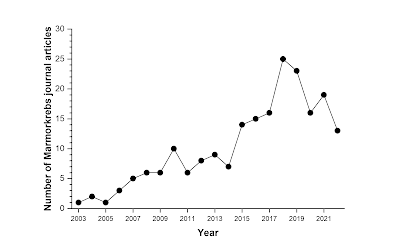This is usually a more optimistic exercise for me.
After years of being able to write that “This was the best year ever,” the last five years show a downward trend in the number of research publications on Marmorkrebs. This graph shows only journal articles, and excludes one interesting article in Crayfish News. Still, even if I included that, this is the least active year in 6 or 7 years.This may be because some of the original research questions about Marmorkrebs – their origin and basic biology – are now resolved. It may also be that because this species is more widespread, new records of introductions are less likely to be reported or published.
The biggest story this year was the expanding use of local legislation to ban or regulate the sale of Marmorkrebs in the pet trade. Someone was actually charged under a law for selling Marmorkrebs for the first time. Ontario and Georgia banned Marmorkrebs, and Minnesota is thinking about it.The Ontario ban is quite significant, given the size and population of the province.
Previous year end reviews
2008 was the best year ever for Marmorkrebs research
2009 was tied for the best year ever in Marmorkrebs research
2010 was the best year ever for Marmorkrebs research
2011 was not the best year ever for Marmorkrebs research
2012 was an average year for Marmorkrebs research
2013 was the second best year ever for Marmorkrebs research
2014 was a good year for Marmorkrebs research
2015 was the best year ever for Marmorkrebs research
2016 was the best year ever for Marmorkrebs research
2017 was the second best year ever for Marmorkrebs research
2018 was the second best year ever for Marmorkrebs research
2019 was the second best year ever for Marmorkrebs research
2020 was not the best year for Marmorkrebs research2021 was the third best year ever for Marmorkrebs research



